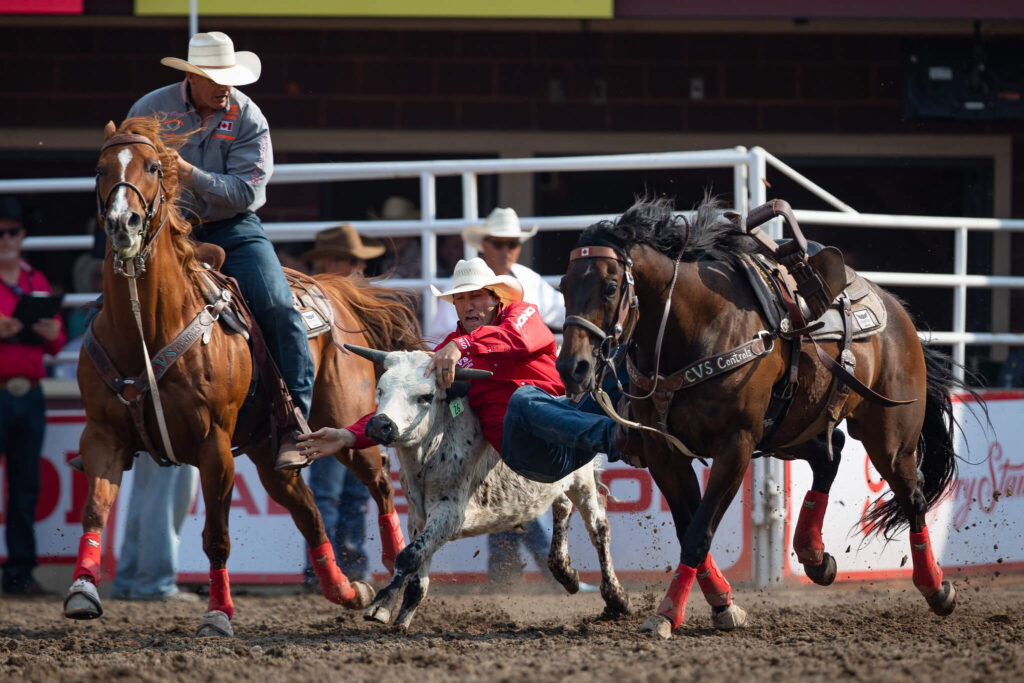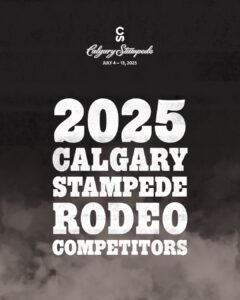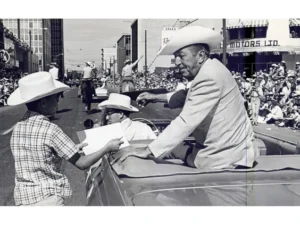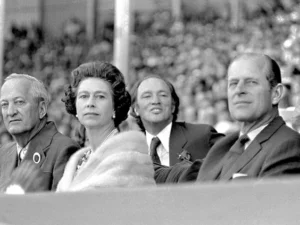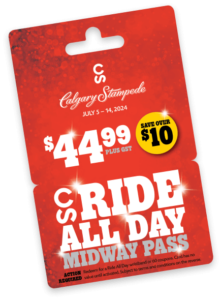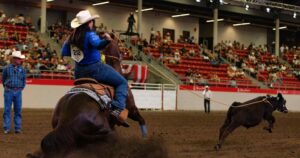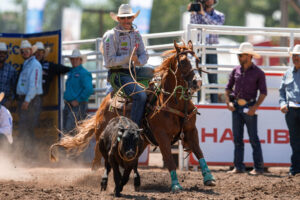Written by: Visit Stampede / Photo Credits:
A Sport Forged on the Frontier
Steer wrestling, also known as bulldogging, is one of rodeo’s most explosive and dramatic events—a true test of courage, timing, and raw strength. Its origins trace back to the late 19th century, when legendary cowboy Bill Pickett is credited with inventing the technique. Pickett, a Black cowboy and rodeo pioneer, would leap from his horse onto a running steer, grab its horns, and wrestle it to the ground—often by biting its upper lip to gain control, a method now outlawed in competition.
Over time, steer wrestling evolved into a regulated sport, with cowboys using skill and strength rather than unorthodox methods. By the early 20th century, steer wrestling had become a staple of professional rodeo, thrilling audiences with its intense action and split-second timing.
The Rules: A Lightning-Fast Showdown
Steer wrestling is all about speed, precision, and teamwork between cowboy and horse. Here’s how it works:
- The Start: The cowboy, mounted on a specially trained “hazer” horse, lines up in a chute opposite the steer. A “hazer” (a second rider) helps keep the steer running straight.
- The Chase: The steer is released, and the cowboy and hazer give chase. The cowboy must match the steer’s speed.
- The Leap: At just the right moment, the cowboy leans from his horse, grabs the steer’s horns, and slides off his mount.
- The Wrestle: Using leverage and strength, the cowboy twists the steer’s head and shoulders, bringing it to the ground.
- The Finish: All four of the steer’s legs must point the same direction for the run to count. The clock stops when the steer is on its side.
Key Points:
- Timing is everything: The cowboy must dismount and wrestle the steer as quickly as possible.
- Teamwork matters: The hazer’s role is crucial in keeping the steer on course.
- Safety first: Steers are carefully selected for size and temperament to ensure fair competition and animal welfare.
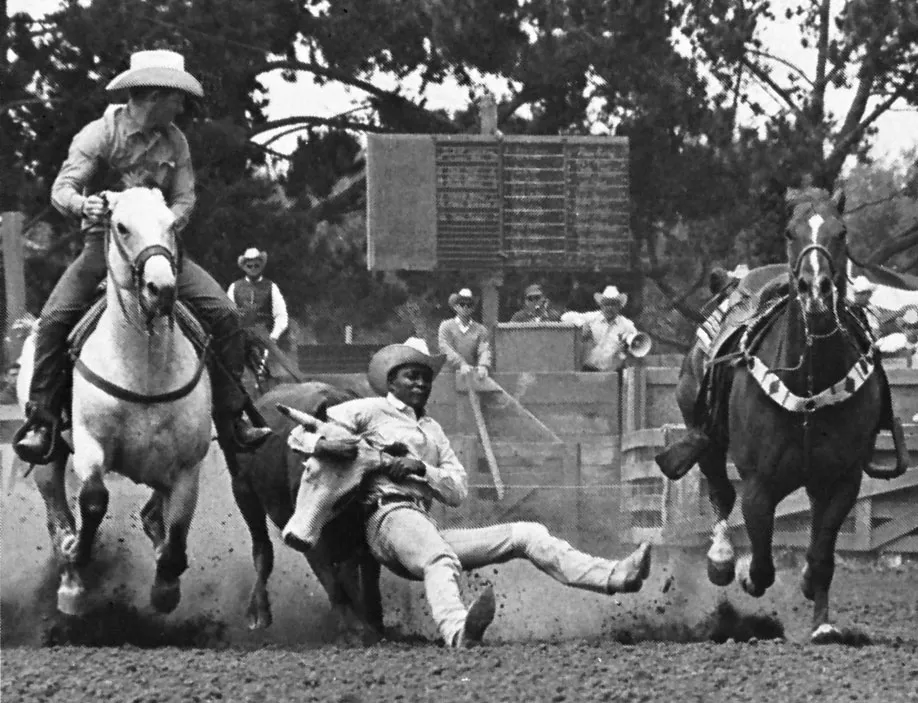
Top Competitors: Legends and Current Stars
Historic Greats:
- Bill Pickett: The father of steer wrestling, whose daring methods inspired the modern sport.
- Buddy Cockrell: A dominant force in the 1950s and 60s.
- Luke Branquinho: Multiple world champion in the 2000s and 2010s, known for his consistency and power.
Current Standouts:
- Tyler Pearson: World champion and one of the top bulldoggers on the circuit.
- Stetson Jorgensen: Known for his explosive starts and quick times.
- Hunter Cure: A consistent contender with multiple world titles to his name.
Steer Wrestling at the Calgary Stampede
At the Calgary Stampede, steer wrestling is a crowd favourite, drawing some of the best athletes in the sport. The Stampede’s high stakes and massive audience make it one of the most prestigious events on the rodeo calendar. Competitors from across North America come to test their skills against the toughest steers and the fastest times.
The Stampede’s unique format, with multiple rounds and a sudden-death showdown for the top finishers, adds extra drama to the event. Fans are treated to heart-stopping action as cowboys risk everything for a shot at the championship buckle and a share of the generous prize money.
Why Steer Wrestling Captivates
Steer wrestling is a true spectacle—a blend of athleticism, bravery, and split-second decision-making. From its roots on the open range to the bright lights of the Calgary Stampede, this event continues to thrill audiences with its raw energy and timeless cowboy spirit.
Whether you’re a seasoned rodeo fan or a first-time spectator, steer wrestling is guaranteed to leave you breathless—and in awe of the cowboys who dare to take on a running steer with nothing but grit and determination.
Does it Hurt the Steer?
The easy answer is no. But like everything in life, it’s not 100% and it’s far more nuanced than most care to admit. The steers who compete are far tougher and stronger than their human counterparts. In most cases, the animal is unharmed in the event. Of course, it is a sport and injuries do happen. Here are the statistics from studies throughout the years:
- In 1994, a survey of 28 sanctioned rodeos was conducted by on-site independent veterinarians. Reviewing 33,991 animal runs, the injury rate was documented at 16 animals or 0.047%, less than one in 2000 animals.
- A study of rodeo animals in Australia found a similar injury rate. Basic injuries occurred at a rate of 0.072%, or one in 1405, with injuries requiring veterinary attention at 0.036%, or one injury in every 2810 times the animal was used, and transport, yarding, and competition were all included in the study.
- A later PRCA survey of 60,971 animal performances at 198 rodeo performances and 73 sections of “slack” indicated 27 animals were injured, again around 0.05%.
Humans, however, are hurt at a far greater rate. About 1% of all rides, result in an injury to the cowboy.
Professional rodeo organizations, such as the Professional Rodeo Cowboys Association (PRCA) and the Canadian Professional Rodeo Association (CPRA), have established extensive rules to protect the welfare of animals in rodeo events, including steer wrestling. Here are the main protections and regulations:
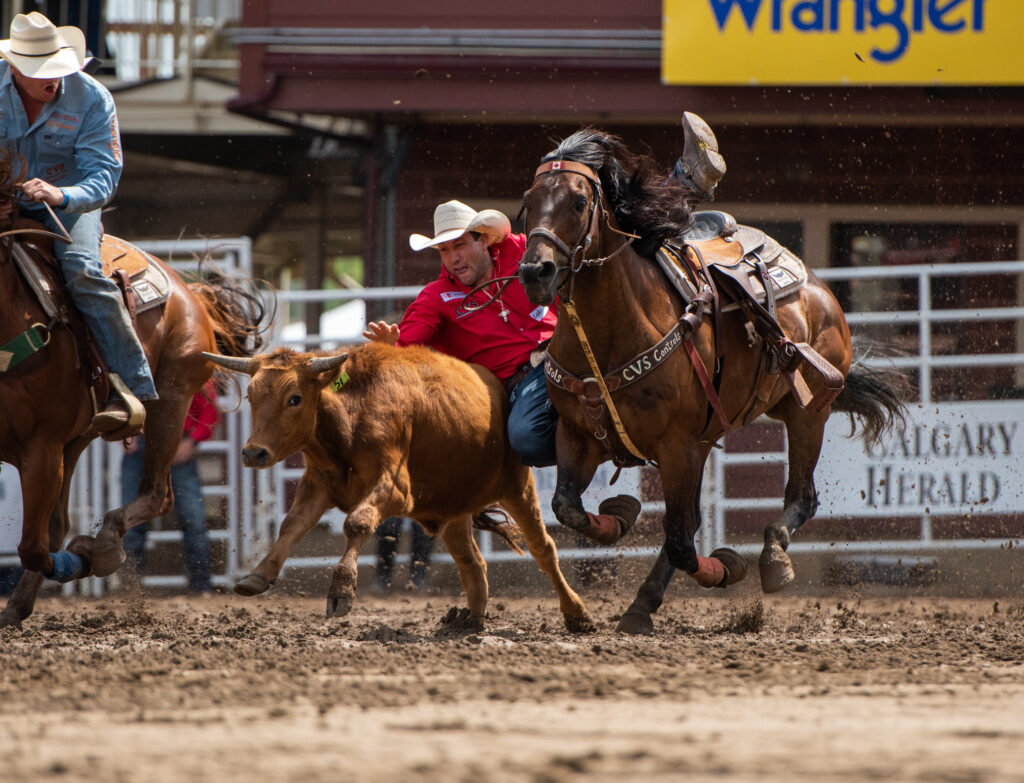
Key Animal Welfare Rules in Rodeo
- Veterinarian Presence:
- A licensed veterinarian must be present at every performance to oversee the health and condition of the animals and to provide immediate care if needed.
- Inspection of Animals:
- All animals are inspected before competition. Animals that are sick, injured, lame, or have impaired eyesight are not permitted to compete.
- If an animal becomes sick or incapacitated after being drawn but before competing, it is withdrawn and replaced.
- Humane Treatment:
- No animal may be treated inhumanely by any member or participant. Abuse or mistreatment of animals is strictly prohibited.
- Any unnecessary non-competitive or competitive action that abuses an animal results in disqualification and fines for the offender.
- Injury Response:
- Injured animals must be removed from the arena immediately and receive veterinary attention.
- No Stimulants or Hypnotics:
- The use of stimulants or hypnotics on animals is prohibited.
- Transportation and Confinement:
- Animals cannot be confined or transported for more than 24 hours without being unloaded, fed, and watered.
- Chute Safety:
- If an animal becomes excessively excited or distressed in the chute, it may be released immediately to prevent injury.
- Equipment Standards:
- All tie-downs and equipment must be padded or covered to prevent injury.
- Judges and Training:
- Rodeo judges receive regular training on animal welfare and are responsible for enforcing these rules during events.
Oversight and Enforcement
- Regulatory Bodies:
- The PRCA and CPRA have over 60 animal welfare rules and employ staff, including a Humane Coordinator, to ensure compliance.
- Veterinary Oversight:
- Veterinarians are present at all performances and have the authority to intervene if an animal’s welfare is at risk.
- Penalties:
- Violations of animal welfare rules can result in fines, disqualification, and suspension from competition.
These rules are designed to ensure that animals are treated with respect and care throughout their participation in rodeo events. While some critics question enforcement and transparency, the official regulations set a high standard for animal welfare in professional rodeo

